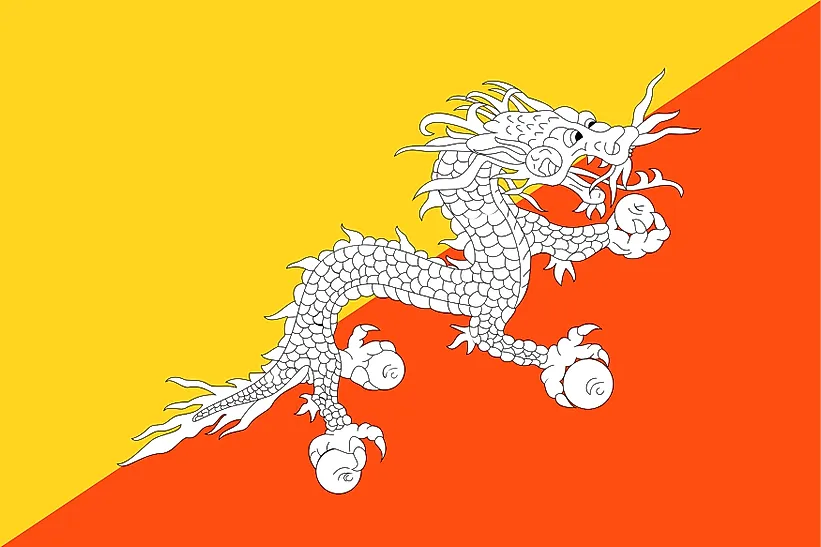
Bhutan
| Continent | Asia |
| Capital | Thimphu |
| Population | 750,125 |
| GDP | $6.43 Billion |
| GDP per Capita | $8,100 |
| Dialing Code | +975 |
| ISO Code (2-letter) | BT |
| ISO Code (3-letter) | BTN |
Bhutan Landscapes






About Bhutan
Welcome to Bhutan, a mystical Buddhist kingdom nestled in the Eastern Himalayas. This nation of approximately 770,000 people occupies 38,394 square kilometers of dramatic mountain terrain between India and Tibet. Known for pioneering the concept of Gross National Happiness as a measure of national progress, Bhutan combines ancient traditions with careful modernization, creating a unique approach to development that prioritizes cultural preservation and environmental conservation.
Geographic Features and Natural Beauty
Bhutan’s geography is dominated by the dramatic landscapes of the Himalayas, with elevations ranging from 160 meters in the southern foothills to more than 7,000 meters in the northern peaks. The country’s terrain creates three distinct climatic zones: the southern subtropical plains, the central temperate valleys, and the northern alpine regions.
The pristine environment, protected by strict conservation laws, includes vast forests covering more than 70% of the country. Bhutan’s commitment to environmental protection is enshrined in its constitution, which mandates that at least 60% of the country must remain under forest cover in perpetuity.
The country features numerous sacred peaks, including Gangkhar Puensum, the world’s highest unclimbed mountain. Crystal-clear rivers flow from the glacial mountains, creating deep valleys and gorges that have shaped Bhutan’s distinct cultural regions.
Cultural Heritage and Traditions
Bhutanese culture is deeply rooted in Tibetan Buddhism, which permeates every aspect of life. The country’s cultural landscape is dotted with dzongs (fortress-monasteries), temples, and prayer flags, while traditional arts and crafts, known as the Zorig Chusum (Thirteen Traditional Crafts), continue to thrive.
The national dress remains mandatory in public places, with men wearing the gho (a knee-length robe) and women wearing the kira (an ankle-length dress). Traditional architecture follows strict ancient guidelines, creating a distinctive and harmonious built environment.
Bhutanese festivals, particularly the tshechus (religious festivals), are vibrant celebrations featuring masked dances, music, and religious ceremonies. These events serve both as spiritual occasions and as means of preserving and transmitting cultural values.
Historical Journey
Bhutan’s history is intertwined with Buddhism, which was introduced to the country in the 7th century. The country was unified in the 17th century by Zhabdrung Ngawang Namgyal, who established the dual system of government combining spiritual and administrative authorities.
Unlike many of its neighbors, Bhutan was never colonized, maintaining its independence through skilled diplomacy and strategic isolation. The country began its careful modernization under the third king in the 1950s and transitioned to a constitutional monarchy in 2008 under the fifth king.
Modern Economic Landscape
Today’s Bhutan follows a unique development philosophy guided by the principle of Gross National Happiness, which balances material progress with spiritual well-being and environmental conservation. The economy is based primarily on hydropower exports to India, tourism, and agriculture.
Tourism operates under a “High Value, Low Impact” policy, requiring visitors to pay a daily minimum fee that includes accommodation, transportation, and guide services. This approach helps preserve the country’s culture and environment while generating sustainable revenue.
The country has made significant strides in education, healthcare, and infrastructure development while maintaining its cultural integrity and environmental standards.
International Relations and Global Position
Bhutan maintains a careful approach to international relations, with India as its closest ally and main development partner. The country joined the United Nations in 1971 and has become an active voice for environmental conservation and sustainable development on the global stage.
Did You Know?
• Bhutan is the world’s only carbon-negative country, absorbing more carbon than it emits?
• Television was only introduced to the country in 1999, making Bhutan one of the last nations to embrace this technology?
• The country banned tobacco sales and smoking in public places, becoming the world’s first smoke-free nation?
• Plastic bags have been banned in Bhutan since 1999, reflecting the country’s strong environmental commitment?
Conclusion
Bhutan represents a unique example of how a nation can pursue development while preserving its cultural heritage and natural environment. From its dramatic mountain landscapes to its vibrant Buddhist culture, from its commitment to happiness to its careful approach to modernization, Bhutan offers valuable lessons in alternative development paradigms. As it continues to navigate the challenges of the 21st century, Bhutan remains committed to its distinctive path of development that prioritizes well-being over material wealth.